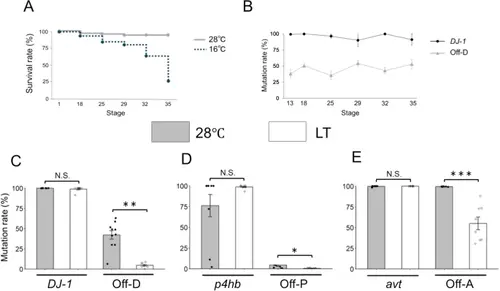Fig. 3
- ID
- ZDB-FIG-250424-5
- Publication
- Yamanaka et al., 2025 - Low-temperature embryo incubation suppresses off-target mutagenesis during CRISPR-Cas9 genome editing in medaka (Oryzias latipes) and zebrafish (Danio rerio)
- Other Figures
- All Figure Page
- Back to All Figure Page
|
Low-temperature treatment (LT) during the early stages of embryonic development reduces off-target mutagenesis without decreasing on-target mutagenesis in medaka. A To investigate the effect of low-temperature conditions on embryo survival, embryos were cultured at 28 °C (126 eggs) and 16 °C (115 eggs). The survival rate at 16 °C dramatically decreased as development progressed. B Temporal changes in on-target and off-target mutation rates were examined. Those of DJ-1 (on-target) and Off-D (off-target) were calculated at each developmental stage (n = 10). While DJ-1 reached nearly 100% mutation rate by Stage 13, Off-D showed no clear upward trend in mutation rate beyond Stage 13. Each data point represents mean ± SE. C, D, E The effect of LT on On-Target and Off-Target mutation rates. (C)DJ-1 and Off-D (n = 8–10) (B) p4hb and Off-P (n = 9) (C) avt and Off-A (n = 8) The 28 °C group was cultured at 28 °C until hatching, while the LT group was cultured at 16 °C until Stage 13, then shifted to 28 °C until hatching. No significant difference in mutation rates was observed in the on-target regions between the LT and 28 °C groups. However, for off-target regions, LT significantly reduced them compared to 28 °C. N.S.: no significant difference, *: p < 0.05, **: p < 0.01, ***: p < 0.001. Columns and error bars represent mean ± SE |

